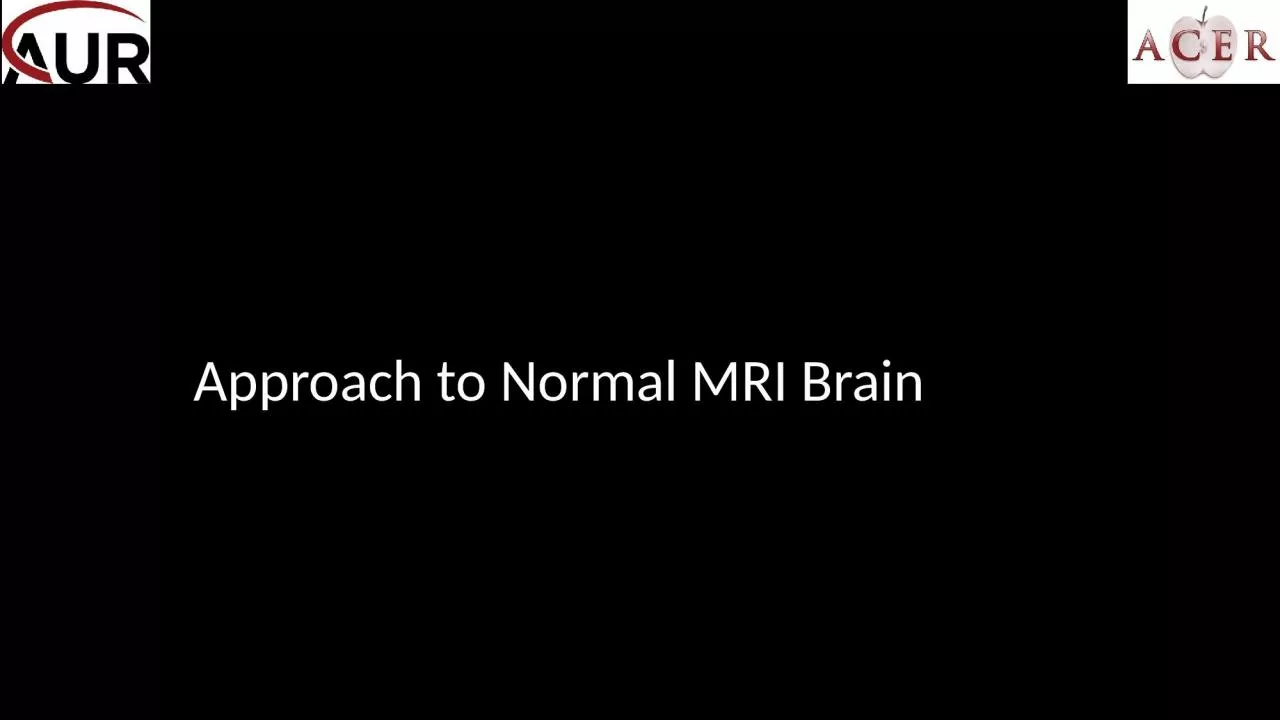

MRI Sequences T1 and T2 weighted sequences On T1 white matter appears white amp grey matter appears grey amp CSF is black On T2 It is the opposite CSF is hyperintense thalamus is darker than the corpus striatum putamen amp caudate which are darker than cortical grey ID: 1042055
Download Presentation The PPT/PDF document "Approach to Normal MRI Brain" is the property of its rightful owner. Permission is granted to download and print the materials on this web site for personal, non-commercial use only, and to display it on your personal computer provided you do not modify the materials and that you retain all copyright notices contained in the materials. By downloading content from our website, you accept the terms of this agreement.
1. Approach to Normal MRI Brain
2. MRI SequencesT1 and T2 weighted sequences:On T1: white matter appears white & grey matter appears grey & CSF is blackOn T2: It is the opposite. CSF is hyperintense, thalamus is darker than the corpus striatum (putamen & caudate) which are darker than cortical grey
3. Examples of T1 and T2 images T 1 weighted T2 weightedCaudate NucleusLentiformNucleusThalamusForamen ofMonro
4. T1 hyperintense (bright) lesions i.e. short T1 lesionsHigh protein: e.g. Rathke cleft cystMineralizationFat & cholesterolSubacute hemorrhage (Meth Hb)Subacute thrombusManganese (e.g. in striatum in liver disease)Melanin
5. T1 hypointense (dark) lesions i.e. lesions with T1 prolongation:CSFEdemaChronic hemorrhageAirflow in blood vesselsLow protein
6. T2 hyperintense (bright) lesions i.e. long T2Sensitive for many pathologies, edema or gliosisEdemaGliosisCSF
7. T2 hypointense (dark) lesions i.e. short T2CalcificationAirFibrous tissueAcute hemorrhageVery chronic hemorrhage (hemosiderin)High proteinCalciumflow in blood vesselsMetal
8. FLAIR (fluid-attenuated inversion recovery)Sensitive but not specifica type of T2 but CSF is black.FLAIR: Helps identify pathologies. shows areas next to CSF (periventricular) very well. Also good for juxtacortical areas. Inferior quality to other sequences in posterior fossa and spinal cord.
9. FLAIRHelps differentiate VR space from Lacunar infarctCauses of FLAIR hyperintensity in sulci SAH High protein (meningitis, neoplastic) High oxygen tension (intubation & ventilation) Artifact.
10. FLAIR imageSuppressionOf normalfluid inVentricles & sulci
11. Diffusion weighted imagingDiffusion imaging uses diffusion of water molecules. Calculates apparent diffusion coefficient ADC that can be displayed on a separate scan.Detects changes in local deoxy- and oxy-hemoglobin ratios, helps localize cognitive (including language) & other functions Apparent diffusion coefficient, ADC:Decreased in cytotoxic edema i.e. opposite to diffusion i.e. true DW restriction i.e. infarct or abscess.Increased from a T2 effect ‘T2 shine-through’ i.e. same as diffusion.Restricted diffusion= high signal on DWI & low signal on ADC
12. Images of DWI and ADCDWIADC
13. Increased DWI seen in acute ischemic strokeImportant to evaluate for diffusion restriction also in encephalitis like herpes focal seizureInfections (like abscess, CJD)Tumors and tumor treatment response (egs like medulloblastoma, epidermoid cyst)Asses extent of diffuse axonal injuryAsses active demyelination
14. GRE & SWI sequencesDetects hemorrhage (hemosiderin) well. Low intensity (called susceptibility artifact or T2* effect).Diffuse axonal injuryHypertension and amyloidosisMultiple cavernomasEvaluation of Venous sinus/cortical vein thrombosis.Infections
15. GRE and SWIT2 * SWI
16. Normal structures that enhance on MRIStructures outside the blood-brain barrier like Dura Adenohypophysis and pituitary stalkPineal glandChoroid plexusNasal mucosaTuber cinereumArea postrema
17. T1 +GadoliniumEnhancing ChoroidPlexusEnhancing Pituitary gland& stalk
18. Disruption of normal blood brain barrier causes enhancement of different lesions on MRI.Enhancement may be seen in :TumorsInfectionsInflammatory conditions such as active demyelinating lesionsSubacute areas of ischemia
19. Sagittal imagesScroll and look at midline image (in the mid-sagittal plane) from bottom to top. Then look laterally at the parasagittal planes. Observe the normal and abnormal structures. Foramen magnum & base of skull including cerebellar tonsilsClivus and nasopharynxFourth ventricle and Cerebellar vermisSella, pituitary & optic chiasmCorpus callosumSuperior sagittal sinusVisualized cervical spine
20. CalvarialmarrowCorpusCallosumPituitaryClivusCerebellar TonsilsMamillary body
21. When interpreting the axial images follow a systematic approach. Scroll through the MRI from bottom to top interpreting each of these systems or areas at a time. The CSF system (ventricles, cisterns and sulci), the brain matter (grey matter structures and white matter structures), the vessels and venous sinuses, the meninges and skull and adjacent tissues. And finally the extended search i.e. review areas (paranasal sinuses, orbits, nasal cavity, visualized tongue and face).
22. Ventricles, cisterns & sulciWhen ventricles, cisterns, fissures or sulci are “squashed” we use the term effaced. When they are large we just describe them as large or enlarged. The different CSF spaces should be interpreted together for example, effaced sulci tell us that the enlarged ventricles likely represent hydrocephalus. Whereas enlarged sulci and enlarged ventricles likely represent brain volume loss Ventricles:Lateral ventricles (frontal, occipital & temporal horns), Third ventricle, fourth ventricleCisterns & fissures:Quadrigeminal plate cistern, interpeduncular cistern, ambient cistern, suprasellar cisternSulci:Appearance: effaced, obscuredVentriulo-sulcal proportionality
23. Brain Grey & white matterMidline shiftGrey white differentiationStructures:Caudate nucleus, Internal capsule, Putamen & globus pallidus, thalamus.Other structures: centrum semiovale, midbrain, pons, medulla, cerebellum
24. Vessels: arteries, veins & venous sinusesArteries: basilar, carotid arteries, vertebral artery, middle cerebral arteriesVenous: Superior sagittal sinus, torcula, transverse sinus, sigmoid sinus, internal jugular vein
25. MeningesDural involvement/enhancement look at (falx, tentorium, CP angle)Leptomeningeal enhancement look at (basal cisterns, cerebellar folia, sulcal perivascular spaces)
26. Extended searchSella, pituitary & optic chiasmParanasal sinuses (ethmoidal, sphenoid, frontal, mastoid), temporal bone/earsOrbitsNasopharynx, Oropharynx